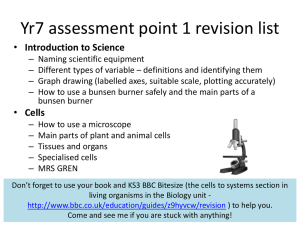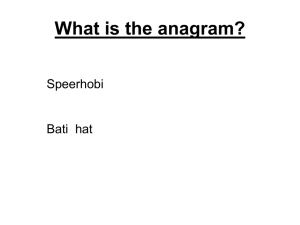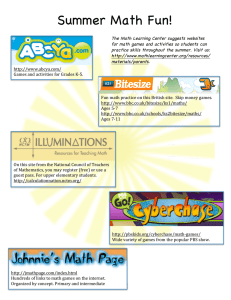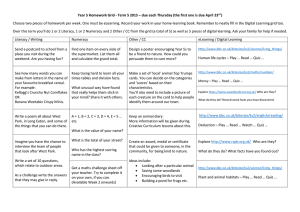National 4 Physics Resource Guide September 2015
advertisement
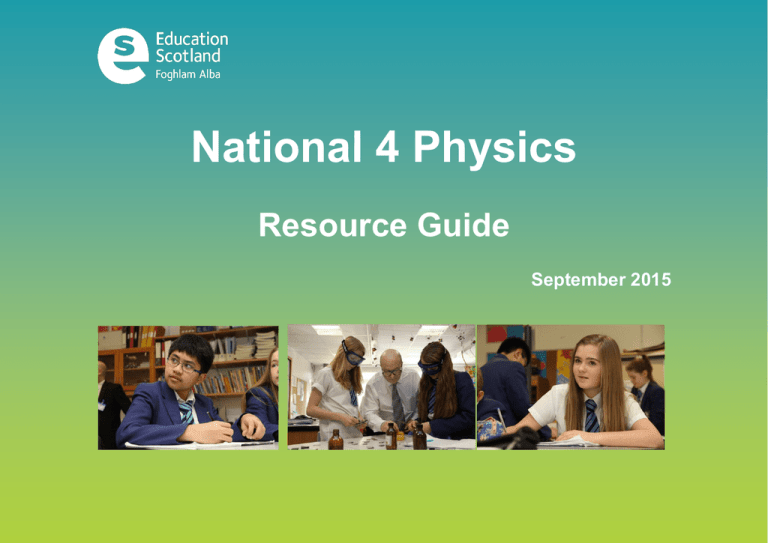
National 4 Physics Resource Guide September 2015 NATIONAL 4 PHYSICS RESOURCES GUIDE National 4 Physics Resources Guide This resource guide has been produced in response to requests from staff who attended the NQ Sciences events at Hampden Stadi um in December 2013. Those attending felt it would be useful to have a document which helped them navigate to the most relevant resources quickly. The following pages show the mandatory course key areas table from the SQA National 4 Physics Course and Unit Support Notes. An additional fourth column has been included which contains hyperlinks to useful resources. Please note: Staff are not required to use the resources listed – they are only included as helpful suggestions. Staff should also refer to the SQA website for the most up-to-date course and unit support notes. To further assist staff links to useful SQA documentation have been included at the beginning of each unit. The SQA documentation relating to the course is shown here along with resources for the Investigation. SQA documents Web link Course specification http://bit.ly/1HISnoO Course and unit support notes http://bit.ly/1efQLYh Update letter June 2014 http://bit.ly/1IEGFdh Education Scotland learning materials Glow NQ course materials portal Glow sciences community http://bit.ly/NQGLOWPHYS http://bit.ly/GLOWPHYS 2 NATIONAL 4 PHYSICS RESOURCES GUIDE Electricity and Energy Unit specification: http://bit.ly/1G6VFNb Suggested learning activities Generation of electricity Knowledge of advantages and disadvantages of different methods of electricity generation. Research energy supply and demand projections from current data. UK Government learner resource – Electricity statistics Research different energy sources. National STEM centre teacher resource – Current affairs: Christmas Knowledge of the potential role of different methods of electricity generation in future sustainable energy supply. Awareness of the concept of energy efficiency and energy efficiency issues related to generation distribution and use of electricity. Knowledge of energy transformations and basic components of power stations. Prepare a plan for a Scottish island to be self-sufficient in electricity from natural resources. Exemplification of key areas Useful resources Mandatory course key areas Institute of Mechanical Engineers learner resource – Scottish energy 2020? Research generation and transmission losses. Scottish Government learner resource – 2006 Scottish energy study Discuss the implications of distribution methods — overhead cables versus underground cables. Education Scotland teacher resource – Energy security context for learning Carry out investigations into generation of electricity, for example, dynamo, and methods of passing a magnet through coil of wire. Compare input and output energy for power stations using different energy sources. Research or investigate the factors affecting the electrical output from a Education Scotland learner resource – Investigating biomass National Museums Scotland teacher resource – Get energised! Energy Savers animation – Renewable energy animations YouTube video – How do different types of renewable energy work? 3 NATIONAL 4 PHYSICS RESOURCES GUIDE range of sources, for example solar cells or wind turbines. BBC Bitesize learner resource – The national grid Research microgeneration such as home-based solar panels, wind turbines or hydro electricity. Ted Ed teacher resource – National grid fully charged Observe a demonstration of model power lines. Cyberphysics teacher resource – The national grid energy distribution National STEM Centre teacher resource – Power lines Ted Ed video – Why aren't we only using solar power? National STEM Centre teacher resource – Desertec BBC Bitesize video – Wind farms (pt 1/3) BBC Bitesize video – Wind farms (pt 2/3) BBC Bitesize video – Wind farms (pt 3/3) YouTube video – Energy 101: electricity generation YouTube video – Where energy comes from 4 NATIONAL 4 PHYSICS RESOURCES GUIDE Electrical power Definition of electrical power as a Compare the efficiency of a National STEM Centre teacher resource – measure of the energy transferred microwave oven to that of a kettle by Appliance science electrically to an appliance every heating water. second. Study.com teacher resource – What is 𝐸 Input energy from smart meter or electrical power? 𝑃= Comparison of power rated power/time and output from 𝑡 consumption of heat producing heat energy in water using specific CK-12 activity – Electric power and electrical and non heat producing heat capacity. energy use appliances, qualitative and 𝑢𝑠𝑒𝑓𝑢𝑙 𝐸𝑜 % 𝑒𝑓𝑓𝑖𝑐𝑖𝑒𝑛𝑐𝑦 = × 100% quantitative. Determine the efficiency of an 𝐸𝑖 CK-12 activity – Power electric motor or water pump. Use of an appropriate relationship BBC Bitesize video – Efficiency of power 𝑢𝑠𝑒𝑓𝑢𝑙 𝑃𝑜 to solve problems involving Compare the brightness of different % 𝑒𝑓𝑓𝑖𝑐𝑖𝑒𝑛𝑐𝑦 = × 100% stations 𝑃 𝑖 power, energy and time. types of lamp using a light meter. Carry out investigations with Physics Central teacher resource – Super Awareness of energy efficiency power/energy meters. efficient LEDs as a key factor in conserving resources and the environment. Compare the information from BBC Bitesize learner resource – Efficiency various power rating plates. Use of an appropriate relationship S-cool simulation – Power and efficiency to solve problems involving efficiency given input and output FuturEnergia teacher resource – A guide to power/energy. teaching across the curriculum about energy efficiency, energy savings and renewable energy solutions Energy Savers teacher resource – Energy management lesson & activity ideas Energy Savers activity – Energy management tips 5 NATIONAL 4 PHYSICS RESOURCES GUIDE Electromagnetism Sketch of magnetic field patterns between magnetic poles. Knowledge of the magnetic effects of electricity. Knowledge of some practical applications of magnets and electromagnets. Use of transformers in high voltage transmission. BBC Bitesize video – Laws of magnetism Draw magnetic field patterns around permanent magnets using iron filings, etc. Investigate the magnetic field patterns around different shapes of electromagnets, for example a linear solenoid or a horseshoe shape. Examine a range of applications using permanent and electromagnets and justify why each type of magnet is used. BBC Bitesize video – A three dimensional magnetic field 𝑁𝑠 𝑉𝑠 = 𝑁𝑝 𝑉𝑝 PhET simulation – Magnets and electromagnets BBC Bitesize video – Magnetism BBC Bitesize video – Magnetism and aviation BBC Bitesize video – Strong magnets BBC Bitesize video – Electromagnets Research the range of applications of electromagnets — relays, bells, loudspeakers, fire door retainers, fail-safe brakes on lifts, Maglev trains, etc. Teach Engineering activity – Hands-on activity: creating an electromagnet NASA teacher resource – Magnetism and electromagnetism BrainPOP teacher resource – Electromagnets SPT teacher resource – Electromagnetism Portland Community College teacher resource – Electromagnet lesson National STEM Centre teacher resource – Motors and electromagnetism 6 NATIONAL 4 PHYSICS RESOURCES GUIDE National STEM Centre teacher resource – GCSE teacher activities Practical electrical and electronic circuits Use of an appropriate relationship to solve problems involving voltage, current and resistance Examine circuit diagrams of hairdryer wiring or car heater wiring for different heat settings. Measurement of current and voltage using appropriate meters in series or parallel circuits. Examine circuit diagrams for vehicle electrical systems such as wiring of ignition and other switches and bulbs and heaters. Knowledge of the circuit symbol, function and application of standard electrical and electronic components including cell, battery, lamp, switch, resistor, variable resistor, voltmeter, ammeter, LED, motor, microphone, loudspeaker, solar cell, fuse, relay, LDR. Identification of analogue and digital input and output devices. Investigate the use of sensors and logic Parallel circuit rules gates in home security systems or environmental and biological monitoring 𝐼𝑠 = 𝐼1 + 𝐼2 systems. 𝑉𝑠 = 𝑉1 = 𝑉2 Investigate the replacement of series/parallel switching in car electrics 1 1 1 = + +⋯ by And/Or logic gates. 𝑅𝑇 𝑅1 𝑅2 𝑉 = 𝐼𝑅 Twig video – Resistance Series circuit rules 𝐼𝑠 = 𝐼1 = 𝐼2 = ⋯ 𝑉𝑠 = 𝑉1 + 𝑉2 + ⋯ The Physics Classroom learner resource – Ohm’s law Nuffield Foundation activity – Ohm’s law and resistance PhET simulation – Ohm’s law Use of an appropriate relationship to solve problems involving the total resistance of resistors in series circuits. Use of AND/OR/NOT logic gates in electronic circuits. Research typical values of current and voltage in electricity distribution systems. Investigate factors affecting resistance. Research the values of resistance of electrical supply cables and flexes for high current appliances. sparkfun learner resource – Voltage, current, resistance, and Ohm's law Twig video – Circuits KScience learner resource – Electrical symbols National STEM Centre teacher resource – Electricity National STEM Centre teacher resource – Episode 114: components in series and parallel The Physics Classroom learner resource – Series Circuits Wisc.online learner resource – Current in a series circuit 7 NATIONAL 4 PHYSICS RESOURCES GUIDE BBC Bitesize learner resource – Voltage across components in a series circuit STEM Central teacher resource – Circuits learning journey PhET simulation – Circuit construction kit (DC only) Nuffield Foundation activity – Simple electric circuits Electronics Tutorials learner resource – Resistors in series Nuffield Foundation activity – Resistance effects schoolphysics learner resource – Logic gates YouTube video – Basic logic gates: explained! 8 NATIONAL 4 PHYSICS RESOURCES GUIDE Gas laws and the kinetic model Knowledge of the kinetic model Observe a demonstration of the kinetic of a gas. model using kinetic theory apparatus. Qualitative knowledge of the effects of varying Research the values of tyre pressures pressure, volume or at different temperatures. temperature on a fixed mass of an ideal gas. Research the use of gas tanks in scuba diving. Awareness of applications of the kinetic model of a gas Research ‘free diving’ and consider the using knowledge of pressure, volume of air in free diver’s lung. volume and temperature (for a fixed mass of an ideal gas). Research weather balloons. Calculate the difference in pressure inside and outside a pressurised aircraft cabin, and the forces acting on the fuselage of the aircraft. Research into the heating and cooling of gases. Twig video – Gas laws IoP activity – Teaching physics in remote places KScience animation – Pressure Twig video – Pressure and surface area KScience animation – Convection BBC Bitesize video – The relationship between heat, volume and temperature BBC Bitesize video – Transfer of kinetic energy to heat energy Nuffield Foundation activity – Molecules in motion YouTube video – Hot air balloon demo Twig video – Cloud in a bottle experiment 9 NATIONAL 4 PHYSICS RESOURCES GUIDE Waves and Radiation Mandatory course key areas Unit specification: http://bit.ly/1FikQeU Suggested learning activities Exemplification of key areas NQ Course Materials teacher resource – Waves and radiation teacher and pupil notes Wave characteristics Comparison of longitudinal and transverse waves. Watch a video analysis of ‘slinky’ waves to determine characteristics. Definition of frequency as the number of waves per second. Watch computer simulations to determine characteristics. 𝑓= Measure the speed, wavelength and frequency of water waves moving along rainwater gutters or ripple tanks filled to different depths. 𝑣 = 𝑓𝜆 Use of an appropriate relationship to solve problems involving frequency, number of waves and time. Use frequency meters to measure frequency. Identification of wavelength and amplitude of transverse waves. Use of an appropriate relationship to solve problems involving wave speed, frequency and wavelength. Useful resources 𝑁 𝑡 NQ Course Materials teacher resource – Waves and radiation equipment list The Physics Classroom teacher resource – Describing waves: the complete toolkit YouTube video – Slinky waves YouTube video – Transverse and longitudinal waves in physics The Physics Classroom simulation – Slinky lab Nuffield Foundation activity – Variety of waves 𝑑 =⊽𝑡 CK-12 learner resource – Waves study guide National STEM Centre teacher resource – Waves YouTube video – Wave machine demonstration 10 NATIONAL 4 PHYSICS RESOURCES GUIDE TedEd learner resource – Making waves: The power of concentration gradients Sasha Wright CK-12 learner resource – Types of waves The Physics Classroom learner resource – The wave equation BBC Bitesize video – Can sound break glass if the right frequency and amplitude are used? BBC Bitesize video – How frequency and amplitude affect pitch and loudness respectively BBC Bitesize video – The rate of vibration or frequency 11 NATIONAL 4 PHYSICS RESOURCES GUIDE Sound Analysis of sound wave forms including changing amplitude and frequency. Knowledge of methods of measurement of the speed of sound in air. Knowledge of sound level measurement, including decibel scale. Awareness of noise pollution and risks to human hearing. Observe oscilloscope patterns. Investigate voice recognition software. Measure the speed of sound in solids, liquids and gases. NQ Course Materials Glow Portal teacher resource – Waves and radiation equipment list Measure typical sound levels in a building. NQ Course Materials Glow Portal learner resource – Sound literacy game Research the effects of exposure to different sound levels and the dangers of prolonged exposure to high sound levels. Twig video – Sound Twig video – Experiments Investigate the absorption of sound by different materials. Knowledge of methods of protecting hearing. Research the technology used in modern hearing aids. Awareness of noise cancellation as a means of reducing the risk of damage to hearing. NQ Course Materials Glow Portal teacher resource – Waves and radiation teacher and pupil notes Research the use of noise-cancelling headphones and noise-cancellation technology in Humvees and helicopters. Research practical uses of sonar, for example measuring the depth of water and finding shoals of fish. Research into the use of ultrasound in medical scanning, and in ranging devices. National STEM Centre activity – SimSound National STEM Centre teacher resource – Visualising sounds with animation The Physics Classroom simulation – Simple wave simulator BBC Bitesize video – The relationship between amplitude and loudness National STEM Centre video – KS3 physics: sound BBC Bitesize video – How does sound 12 NATIONAL 4 PHYSICS RESOURCES GUIDE Awareness of applications of sonar and ultrasound. Awareness of sound reproduction technologies. Experiment with the production of notes in a variety of musical instruments. Explore technology used to record and enhance sound. travel through a liquid? BBC Bitesize video – How does sound travel through a solid? BBC Bitesize video – How does sound travel through air? National STEM Centre teacher resource – Noise monitoring CK-12 learner resource – Sound waves TedEd learner resource – The sonic boom problem - Katerina Kaouri BBC Bitesize video – Reverberation of sound BBC Bitesize video – The relationship between vibrations and sound BBC Bitesize video – Vibrations and sound waves SSERC teacher resource – Audacity resources [SSERC] SSERC teacher resource – Audacity study of sound 13 NATIONAL 4 PHYSICS RESOURCES GUIDE SSERC teacher resource – Audacity further experiments Electromagnetic Spectrum Knowledge of applications Research parts of the EM spectrum and hazards associated with including: Gamma rays, X-rays, Ultraviolet electromagnetic radiations. radiation, visible light, Infrared radiation, Microwaves, Radio waves. Applications in industry or leisure. Typical jobs which would use the radiation. Knowledge of approaches to minimising risks associated with electromagnetic radiations. Description of how invisible parts of the EM spectrum can be detected. NQ Course Materials Glow Portal teacher resource – Waves and radiation equipment list Possible hazards of the radiation. Safety precautions to be taken with the radiation. For example, sunglasses to protect from UV and IR. Study.com learner resource – Electromagnetic waves: definition, sources & properties Detection of EM radiation: Twig video – EM spectrum devices (eg ovens, TVs, mobile phones, tablet computers and Wi-Fi hubs m a remote control handset on an oscilloscope using phototransistor, IR sensitive sheets or similar spectral analysis plot on digital camera display or photo editing software 14 NQ Course Materials Glow Portal teacher resource – Waves and radiation teacher and pupil notes National STEM Centre teacher resource – Invisible wavelengths YouTube video – The electromagnetic spectrum song TeacherTube video – The electromagnetic spectrum CK-12 learner resource – Electromagnetic waves NATIONAL 4 PHYSICS RESOURCES GUIDE Light — application of lenses to correct long and short sight Description of refraction in terms of change of direction (where angle of incidence is greater than 0˚). Study.com learner resource – The 7 major regions of the electromagnetic spectrum NQ Course Materials Glow Portal activity – X-ray activity TedEd learner resource – Light waves, visible and invisible: Lucianne Walkowicz BBC Bitesize video – Electromagnetic spectrum classroom resources Brightstorm learner resource – Electromagnetic spectrum The Physics Classroom learner resource – The angle of refraction The Physics Classroom learner resource – Refraction and sight NQ Course Materials Glow Portal learner resource – The telescope (refraction and lenses) learner notes NQ Course Materials Glow Portal teacher resource – The telescope (refraction and lenses) staff guide 15 NATIONAL 4 PHYSICS RESOURCES GUIDE Nuclear radiation Knowledge of natural and artificial sources of nuclear radiation and associated medical and industrial applications. Consideration of the pros and cons of generating electricity using nuclear fuel. Comparison of risk due to nuclear radiation with risk due to other environmental hazards (eg global warming) and the management of these risks. Discuss the arrangement of neutrons, protons and electrons in an atom. Research into sources and effects of nuclear radiation including natural sources (eg radon) man-made sources (eg plutonium), their effects on living things (eg leukaemia) and their effects on non-living things (scintillation, sparks between high voltages). NQ Course Materials Glow Portal teacher resource – Waves and radiation teacher and pupil notes NQ Course Materials Glow Portal teacher resource – Waves and radiation equipment list BBC Bitesize activity – Atoms and atomic structure activity Twig video – Radioactivity YouTube video – Effects of nuclear radiation on the human body Curiosity video – How much radiation is harmful? Cyberphysics learner resource – Science in the news: nuclear radiation Cyberphysics teacher resource – Radioactivity index National STEM Centre teacher resource – GCSE teacher activities IoP teacher resource – Teaching radioactivity 16 NATIONAL 4 PHYSICS RESOURCES GUIDE Dynamics and Space Unit specification: http://bit.ly/1MVF4S4 Mandatory course key areas Suggested learning activities Speed and acceleration Use of an appropriate relationship to solve problems involving speed, distance, and time. Measure the average speed of trolley moving down a slope or along a level bench. Determination of average and instantaneous speed. Interpretation of speed-time graphs to describe motion including calculation of distance (for objects which are speeding up, slowing down, stationary and moving with constant speed.) Motion in one direction only. Exemplification of key areas 𝑑 =⊽ 𝑡 Use light gates/motion sensors to measure speed. NQ Course Materials Glow Portal teacher resource – Physics support materials National 4/National 5 Produce speed time graphs using motion sensors and appropriate computer software. BBC Bitesize video – How to calculate average speed Draw a speed time graph of a car’s journey by measuring speed at different times from video of speedometer during journey. Use of an appropriate relationship to solve problems involving acceleration, change in speed and time. Determine the acceleration of sports cars, theme park rides and space vehicles from research data. NQ Course Materials Glow Portal teacher resource – Dynamics and space teacher and pupil notes NQ Course Materials Glow Portal teacher resource – Dynamics and space equipment list Measure the acceleration of a vehicle using two light gates and a stopwatch. Discuss how light gates could be used in sports (timing races, measuring instantaneous and average speed). Useful resources BBC Bitesize video – How to calculate the speed of a car National STEM Centre teacher resource – Speed pairs PhET simulation – The moving man 𝑎= Δ𝑣 t NQ Course Materials Glow Portal activity – Speed time graph activity NQ Course Materials Glow Portal learner resource – Speed time graph 17 NATIONAL 4 PHYSICS RESOURCES GUIDE APS Physics teacher resource – Viewpoint: making a supersonic jet in your kitchen The Bloodhound Project teacher resource – Bloodhound education and engagement National STEM Centre video – The Bloodhound SSC project National STEM Centre teacher resource – Investigating motion The Physics Classroom teacher resource – Position-velocity-acceleration - complete toolkit Nuffield Foundation activity – Distinguishing between velocity and acceleration National STEM Centre video – Secondary science using ICT: investigating acceleration using light gates Nuffield Foundation activity – Finding average acceleration with a ticker-timer Nuffield Foundation activity – Investigating motion on a sloping surface Nuffield Foundation activity – Measurement of acceleration using light gates 18 NATIONAL 4 PHYSICS RESOURCES GUIDE Relationship between forces, motion and energy Use of Newton’s first law and balanced forces to explain constant speed for a moving object, making reference to frictional forces. Use of Newton’s second law to explain the movement of objects in situations involving constant acceleration. Use of an appropriate relationship to solve problems involving force, mass and acceleration in situations where only one force is acting. Use of an appropriate relationship to solve problems involving weight, mass and gravitational field strength. Knowledge of the risks and benefits associated with space exploration including the challenges of re-entry to a planet’s atmosphere and the use of thermal protection systems to protect spacecraft on re-entry. NQ Course Materials Glow Portal learner resource – The physics of flight learner notes Measure the forces needed to change the shape of an object, and the speed and direction of the motion of an object. NQ Course Materials Glow Portal teacher resource – The physics of flight staff guide Use an office fan to move lowfriction trolley with a ‘sail’. NQ Course Materials Glow Portal teacher resource – Dynamics and space teacher and pupil notes Use an office fan to change direction of light ball thrown into the air. Experiment with placing different weights onto all ball of plasticine and compare the changes in its shape. NQ Course Materials Glow Portal teacher resource – Dynamics and space equipment list NQ Course Materials Glow Portal teacher resource – Physics support materials National 4/National 5 Investigate the relationship between mass and weight using a Newton balance. Use sandpaper or a rubber to demonstrate that friction converts movement energy to heat. Relate this to a spacecraft moving at high speed through the atmosphere of a planet during re-entry. Investigate the thermal conductivity of different materials. Physics Central activity – Balloon acceleration in a car 𝐹 = 𝑚𝑎 BBC Bitesize video – Forces, motions and energy classroom resources 𝑊 = 𝑚𝑔 The Physics Classroom simulation – Newton’s laws Backstage Science video – Feather in vacuum Exploratorium activity – Paper airplanes 19 NATIONAL 4 PHYSICS RESOURCES GUIDE National STEM Centre teacher resource – Crash investigators National STEM Centre video – Kung Fu physics National STEM Centre teacher resource – Dodging bullets Nuffield Foundation activity – Investigating Newton's second law of motion Nuffield Foundation activity – Compensating for friction Nuffield Foundation activity – Friction, turning and other effects Nuffield Foundation activity – Feeling a force of 10 N National STEM Centre teacher resource – Space:uk - winter 2011, issue 33 20 NATIONAL 4 PHYSICS RESOURCES GUIDE Satellites Knowledge of the range of heights and functions of satellites in orbit around the earth, including geostationary and natural satellites. Knowledge of the qualitative relationship between the altitude of a satellite and its period. Knowledge of the use of parabolic reflectors to send and receive signals. Use of the relationship between distance, speed and time applied to satellite communication. Awareness of a range of applications of satellites including telecommunications, weather monitoring, their use in environmental monitoring, and developing our understanding of the global impact of mankind’s actions. Investigate the relationship between orbital height and period by using computer simulations or data from internet. Investigate the uses of different satellites related to the orbital period or height and their potential impact on society. Investigate reflection from curved reflectors with ray boxes or microwave kit. NQ Course Materials Glow Portal teacher resource – Dynamics and space teacher and pupil notes NQ Course Materials Glow Portal teacher resource – Dynamics and space equipment list 𝑑 =⊽ 𝑡 NQ Course Materials Glow Portal teacher resource – Physics support materials National 4/National 5 BBC Bitesize video – Satellite motion National STEM Centre video – Satellites Research the use of solar furnaces for heating water in developing countries and the potential social benefits. Science Learning learner resource – Satellites and orbits National STEM Centre teacher resource – Which satellite am I? Science Learning activity – Student activity - Investigating satellite dishes Science Learning activity – Student activity - Satellite web hunt SEGway teacher resource – The great satellite search National STEM Centre teacher resource – The James Webb Space Telescope: 21 NATIONAL 4 PHYSICS RESOURCES GUIDE inspiration and context for physics and chemistry teaching National STEM Centre teacher resource – Structures 14 to 16 National STEM Centre teacher resource – Watching over the Earth National STEM Centre video – A day in the life of UK space scientists and engineers National STEM Centre teacher resource – Sky’s the limit for UK satellite company National STEM Centre teacher resource – Salters' science focus: teachers' guide 1 National STEM Centre teacher resource – Space:uk autumn 2009, issue 28 Multiverse teacher resource – The EUVE orbit 22 NATIONAL 4 PHYSICS RESOURCES GUIDE Cosmology Description of planet, moon, star, solar systems, exo-planet, galaxy and universe. Awareness of the scale of the solar system and universe measured in light years. Awareness of space exploration and its impact on our understanding of the universe and planet Earth. Consideration of the conditions required for an exo-planet to sustain life. Research data for solar system including mass, time to orbit the Sun, surface temperature range, number of moons, time for one rotation, etc and present data graphically or pictorially. Research the nature and scale of the universe (planet is part of a solar system; solar system is part of a galaxy) using computer simulations or internet search. Research data on galaxies, for example the Whirlpool galaxy, possible using support from the Royal Observatory Edinburgh Galaxies Project or Galaxy Zoo software. Investigate whether exo-planets could support life, possibly using support from the Royal Observatory Edinburgh Exo-planets Project. NQ Course Materials Glow Portal teacher resource – Dynamics and space teacher and pupil notes NQ Course Materials Glow Portal teacher resource – Dynamics and space equipment list NQ Course Materials Glow Portal teacher resource – Physics support materials National 4/National 5 Multiverse activity – At home astronomy National STEM Centre teacher resource – Resources for teaching astronomy in UK schools IoP video – Teaching astronomy and space videos HTwins.net simulation – The scale of the Universe IoP teacher resource – Creative physics activities IoP teacher resource – Exoplanet physics National STEM Centre teacher resource – Exoplanets 23 NATIONAL 4 PHYSICS RESOURCES GUIDE National STEM Centre video – Exoplanets TedEd learner resource – How to detect a supernova - Samantha Kuula National STEM Centre teacher resource – Galaxies and cosmology presentations National STEM Centre teacher resource – The transit method National STEM Centre video – Eating, sleeping, drinking and living in space National STEM Centre teacher resource – Is there anyone out there? National STEM Centre teacher resource – The habitable zone National STEM Centre teacher resource – Exoplanet atmospheres National STEM Centre teacher resource – Radius and volume of exoplanets National STEM Centre teacher resource – Space:uk - March 2009, issue 27 24
